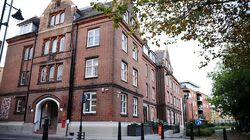| DISTRICT | ||
| Bethnal Green | ||
|---|---|---|
| Image | ||
| Population | ||
| PostCode District | E1, E2 | |
| Borough | London Borough of Tower Hamlets | |
| OS Grid Reference | ||
| Latitude | ||
| Longditude | ||
Bethnal Green is an area in East London, located in the London Borough of Tower Hamlets, and is considered to be a part of the East End.
Toponymy[]
The first recorded names for Bethnal Green were Blithehale and Blythenhale. These could be translated as happy corner, although nobody is exactly sure where the name came from. Over time, the area became known as Blethenal Green and then Bethan Hall Green. The current name for the area probably came from the local pronunciation of Bethan Hall Green, ultimately leading to the connecting of Bethan and Hall to Bethnal.[1]
The topographer Daniel Lysons suggested in the late 18th century that Bethnal was a corruption of the name Bathon-Hall which would have been the residence of a notable Bathon family who owned large areas of Stepney, the parish of which Bethnal Green was once a part. "Green" related to an area which lay "about half a mile beyond the suburbs".[2]
History[]
A settlement was recorded in the 13th century, and by the 16th century merchants and noblemen were building large houses in the fields and Bethnal Green remained a pleasant country retreat on the outskirts of London until about 1700 and[3] became a manufacturing districts in Middlesex, known for it silk-weaving.[4]
In the 1700s, east of the village was known as Eastfields,[5] a patch of green with some residential houses, and by late 1700s, estate developers gained an interest in it.[6]
During the 1800s, Bethnal Green had became home to an influx of silk weavers who spilled over from Spitalfields, this led to a need for more housing, in response, development began east of the green. Bethnal Green also became well-known for its market gardens, however by the end of the 19th century, the area was turning into a slum and was overcrowded, with inadequate housing and suffered from poverty and crime related problems.[7] From the 1860s philanthropists like Angela Burdett-Coutts and George Peabody built tenement housing for the poor. Burdett-Coutts also sponsored the construction of a spectacular market hall in Columbia Road, which was never a success and has not survived.[8]
Bethnal Green was in the NE postcode area in 1857,[9] which was abolished following a report by Antony Trollope and then merged into the E postcode area in 1866.[10]
The southern part of Mansford Street was laid out in 1877 as a through road in a cleared area between Old Bethnal Green Road and Bethnal Green Road with building land on either side.[11]
In 1909, the Sutton Dwellings Trust, which was founded by William Sutton, acquired an acre of land on the west side of James Street (once North and later Sceptre Road) and opened the Bethnal Green Estate in 1909.[12] The Bethnal Green Town Hall was completed in 1910[13] and the internationally renowned York Hall opened in 1929 with a capacity of 1,200.[14]
A total of 173 people, mainly women and children, died in the Bethnal Green tube station tragedy, March 3rd, 1943 and was Britain’s worst mass civilian death incident of the Second World War.[15]
Between 1931 and 1955 nearly 40,000 residents of Bethnal Green were relocated into London County Council homes in Essex and later into Buckinghamshire. This caused a breakup of the social order and a contraction of privately rented housing. These conditions contributed to outrageous rents and the development of the slum lord along with an increase in criminal behavior.[16]
Community[]

Oxford House.
Below are local community centres and groups for Bethnal Green:
- Bethnal Green Community Centre - cottage back of Whitman House, Bethnal Green Estate[17]
- Oxford House - an arts and community centre[18]
- Love Bethnal Green - a website promoting the area.[19]
- Bethnal Green LDN - a magazine for Bethnal Green.[20]
- St. Margaret's House - community centre on Old Ford Road[21]
References[]
The Wikipedia article is at [22]